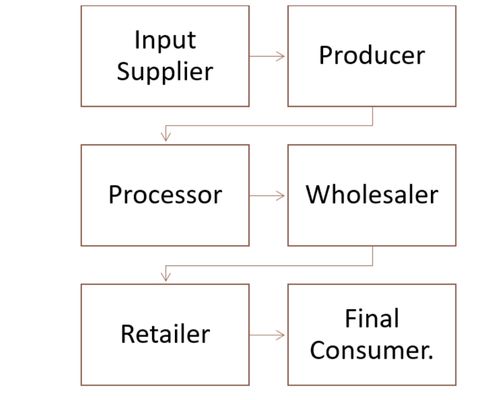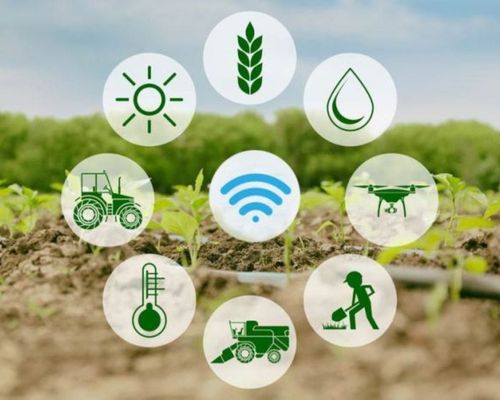This blog talks about functioning of supply chain in agriculture,challenges faced by farmers and traders and the role of digitization in transforming the agriculture supply chain.
India annually produces 75 million tonnes of fresh fruit and 146 million tonnes of vegetables. Due to their perishability, seasonality, and bulkiness, fruits and vegetables offer more marketing challenges than several commercial products. Marketing for fruits and vegetables is made more challenging by the diverse consumption habits of Indian customers and a weak supply chain infrastructure. This blog explores numerous difficulties related to managing the supply chain for fruits and vegetables and examines several solutions that can be used to improve the supply chain.

Supply chain in agriculture
Supply chains generally focus on the movement of goods and information among their constituent companies—the acquisition of raw materials, their transformation into finished goods, and their distribution to final consumers. Agri fresh produce supply chain begins with the grower/farmer, who sells their produce to primary processors, who process the products before packing and shipping them to wholesalers. Supply chains are information-driven and help businesses cut costs, add value to their products, use resources more efficiently, speed up time to market, and keep consumers.
The true measure of supply chain success is how well operations across the supply chain coordinate to produce value for consumers while enhancing the profitability of each link in the supply chain. To put it another way, supply chain management is an integrated process for creating value for the final consumer.
Role of fresh produce in the Agri supply chain
A significant factor for the in-store traffic in supermarkets and convenience stores is the availability of fresh produce. Consumers rank high-quality fruits and vegetables as the most significant factor when choosing their primary retailers.
Recent trends are raising serious questions regarding the future viability of products. Extreme weather fluctuations, rising food consumption, significant productivity gaps in agriculture between India and its regional neighbours, and the need to control food prices and import output to meet demand have all shown that India needs to reconsider its strategy.

Major setbacks in the Agri-supply chain
Challenges faced by Farmers
Indian farmers face several difficulties, the most significant of which is farmers cannot sell their produce at fair prices. There is an excessive strain on the health of the land, water, and soil, a lack of knowledge about high-value/growth goods, restricted exposure to high productivity practices, weak market ties, inefficient supply chains with significant food waste, and strict reliance on rainfall. The entire value chain, from research to the point where farmers are able to realize money in their pockets, needs to be captured if we are to bring about an income revolution in the agricultural sector.
1. Lack of liquidity for farmers:
The glaring inequalities between small and large farmers open the Agri supply chain to unethical trading practices. Farmers sometimes struggle with a lack of cash due to payment delays and unfair crop prices. They cannot buy inputs for the upcoming season as a result, which causes disparity and forces them to take out loans with exorbitant interest rates.
2. Insufficient postharvest infrastructure:
The lack of postharvest infrastructure at the farm level is a significant gap in the supply chain for Agricultural /horticulture commodities. Sorting, grading, washing, packaging, and other crop-specific postharvest activities are essentially nonexistent at the farm-proximate level; farm-level collecting centres are mainly absent. This causes more losses and lesser value realization by those involved in the value chains, particularly the producers.
3. Maintaining the shelf life of produce:
Fresh foods must be kept throughout the supply chain at the proper temperatures and humidity levels. A temperature range of 0 to 2 degrees Celsius and a humidity range of 95% to 100% are required for fruits like oranges, grapes, and cherries. On the other hand, since high humidity affects certain goods, such as garlic and onions, they must be stored at a comparable temperature but at humidity levels between 65% and 75%. Other goods, such as bananas, avocados, and mangoes, are prone to deterioration from the cold and must be stored between 13 and 15 degrees Celsius and between 85% and 90% humidity.
The shelf life of products is drastically reduced due to inadequate storage facilities, which lowers the produce quality. This causes substantial losses for farmers. The high amount of production losses occur due to lower quality and safety standards brought on by customer preferences, especially in developed nations. Fresh agricultural goods sometimes experience significant losses (up to 30% per year) during postharvest handling.
Challenges faced by Traders
There are many hurdles for traders in the agriculture supply chain. The inefficiency of the agricultural supply chain is made more problematic by the lack of traceability, expensive maintenance costs, and many other issues. Some of the major challenges are discussed below:
1. Poor packaging techniques:
Most of the time, produce is transported to mandi/units without adequate packaging, buffering, or insulation, resulting in significant waste losses. Produce is typically dumped on the ground in the market yards for weighing and price haggling. Before being dumped back into the conveying truck for additional transportation, some manual sorting and grading are done in the market yards. This handling produces higher waste.
2. Security and Safety Concerns:
Several food safety laws must be followed by fresh produce logistics, including guidelines for packaging, shipping, sanitation, and warehousing rules to name a few. For instance, the trucks used must meet ISO specifications and be able to handle various loading demands. At every point in the supply chain, breaking one of these regulations could have adverse financial and legal effects.
3. Exorbitant Maintenance
Compared to a conventional supply chain, the cost of a fresh produce supply chain is higher due to the requirement to maintain the proper conditions, ensure quality packaging, and permit quick shipping.
Digital technology: solution to these challenges
A clear long-term vision for digital agriculture is now essential since farming players are facing a more challenging environment due to rising food demand and limited resources, especially after covid 19 pandemic. Distressing circumstances, like the ongoing epidemic, have also brought attention to the necessity of a more effective and robust supply chain. However, digital technologies provide a whole new set of tools to help stakeholders create a modern supply chain that can address all present difficulties and create new value for those looking to innovate beyond basic needs.
For example, today, India boasts one of the world’s most effective soil health management systems. The industry anticipates utilizing numerous digital technologies during pre-production, production, and post-production.

How does digital technology help?
- Improved access to inputs: Giving farmers more straightforward access to agricultural inputs close to their homes helps them determine the appropriate input to boost productivity and yield.
- Financing: Farmers face financial difficulties. However, various government subsidies are enforced that assist such farmers in promptly obtaining loans.
- Digital Agriculture: Companies specializing in digital or precision agriculture provide cutting-edge technology solutions to boost agricultural productivity and the efficiency of farming.
- Increasing the efficiency of the supply chain: Market linkage technology offers a digital platform that links agricultural products with prospective buyers.
- Farming as a service: It provides cutting-edge, expert-level solutions for agricultural and allied services using a subscription-based or pay-per-use business model. It Provides farmers with affordable technology by making costly produce easily accessible and turning fixed costs into variable expenses.
How can Fasal assist?
- Fasal is an IoT-based agricultural company that provides end-to-end traceability to farmers.
- It helps farmers increase the supply chain’s efficiency by assisting them in selling their produce and linking them to prospective buyers.
- The Fasal system enables traders to obtain fresh produce directly from farms and assists in maintaining the consistency of product quality.
- The traders can plan ahead for their products in the supply chain and track their produce with the Fasal system.
- Fasal can help farmers to sell their harvest at better prices along with Sorting, Grading, Packaging, and Logistics facilities.
- The technology of Fasal is based on the idea of precision agriculture. It also provides crop, time, and location-specific solutions to farmers that help in increasing their productivity.
- The AI-based system of Fasal assists farmers in accurately measuring irrigation, soil, temperature, and canopy level requirements, thus enabling them to maintain better marketable quality produce.
Want to know more? Connect directly with Fasal!

Leave a comment